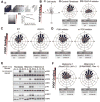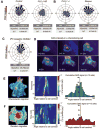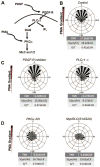Mesenchymal chemotaxis requires selective inactivation of myosin II at the leading edge via a noncanonical PLCγ/PKCα pathway
- PMID: 25482883
- PMCID: PMC4276478
- DOI: 10.1016/j.devcel.2014.10.024
Mesenchymal chemotaxis requires selective inactivation of myosin II at the leading edge via a noncanonical PLCγ/PKCα pathway
Abstract
Chemotaxis, migration toward soluble chemical cues, is critical for processes such as wound healing and immune surveillance and is exhibited by various cell types, from rapidly migrating leukocytes to slow-moving mesenchymal cells. To study mesenchymal chemotaxis, we observed cell migration in microfluidic chambers that generate stable gradients of platelet-derived growth factor (PDGF). Surprisingly, we found that pathways implicated in amoeboid chemotaxis, such as PI3K and mammalian target of rapamycin signaling, are dispensable for PDGF chemotaxis. Instead, we find that local inactivation of Myosin IIA, through a noncanonical Ser1/2 phosphorylation of the regulatory light chain, is essential. This site is phosphorylated by PKCα, which is activated by an intracellular gradient of diacylglycerol generated by PLCγ. Using a combination of live imaging and gradients of activators/inhibitors in the microfluidic chambers, we demonstrate that this signaling pathway and subsequent inhibition of Myosin II activity at the leading edge are required for mesenchymal chemotaxis.
Copyright © 2014 Elsevier Inc. All rights reserved.
Figures







Comment in
-
Unleashing mesenchymal chemotaxis.Dev Cell. 2014 Dec 22;31(6):669-70. doi: 10.1016/j.devcel.2014.12.005. Dev Cell. 2014. PMID: 25535912
Similar articles
-
Unleashing mesenchymal chemotaxis.Dev Cell. 2014 Dec 22;31(6):669-70. doi: 10.1016/j.devcel.2014.12.005. Dev Cell. 2014. PMID: 25535912
-
Hepatic stellate cell protrusions couple platelet-derived growth factor-BB to chemotaxis.Hepatology. 2007 Jun;45(6):1446-53. doi: 10.1002/hep.21606. Hepatology. 2007. PMID: 17465006
-
Modification of PI3K- and MAPK-dependent chemotaxis in aortic vascular smooth muscle cells by protein kinase CbetaII.Circ Res. 2005 Feb 4;96(2):197-206. doi: 10.1161/01.RES.0000152966.88353.9d. Epub 2004 Dec 9. Circ Res. 2005. PMID: 15591231
-
A discourse on cancer cell chemotaxis: where to from here?IUBMB Life. 2007 Feb;59(2):60-7. doi: 10.1080/15216540701201033. IUBMB Life. 2007. PMID: 17454296 Review.
-
Chemotactic signaling in mesenchymal cells compared to amoeboid cells.Genes Dis. 2014 Sep 28;1(2):162-173. doi: 10.1016/j.gendis.2014.09.006. eCollection 2014 Dec. Genes Dis. 2014. PMID: 30258862 Free PMC article. Review.
Cited by
-
The principles of directed cell migration.Nat Rev Mol Cell Biol. 2021 Aug;22(8):529-547. doi: 10.1038/s41580-021-00366-6. Epub 2021 May 14. Nat Rev Mol Cell Biol. 2021. PMID: 33990789 Free PMC article. Review.
-
Macrophage network dynamics depend on haptokinesis for optimal local surveillance.Elife. 2022 Mar 28;11:e75354. doi: 10.7554/eLife.75354. Elife. 2022. PMID: 35343899 Free PMC article.
-
Optical control of MAP kinase kinase 6 (MKK6) reveals that it has divergent roles in pro-apoptotic and anti-proliferative signaling.J Biol Chem. 2020 Jun 19;295(25):8494-8504. doi: 10.1074/jbc.RA119.012079. Epub 2020 May 5. J Biol Chem. 2020. PMID: 32371393 Free PMC article.
-
Ouabain-induced activation of phospholipase C zeta and its contributions to bovine sperm capacitation.Cell Tissue Res. 2021 Sep;385(3):785-801. doi: 10.1007/s00441-021-03455-2. Epub 2021 Apr 22. Cell Tissue Res. 2021. PMID: 33885964
-
Non-muscle myosin 2 at a glance.J Cell Sci. 2023 Mar 1;136(5):jcs260890. doi: 10.1242/jcs.260890. Epub 2023 Mar 14. J Cell Sci. 2023. PMID: 36917212 Free PMC article. Review.
References
-
- Bear J, Loureiro J, Libova I, Fassler R, Wehland J, Gertler F. Negative regulation of fibroblast motility by Ena/VASP proteins. Cell. 2000;101:717–728. - PubMed
-
- Bear JE, Svitkina TM, Krause M, Schafer DA, Loureiro JJ, Strasser GA, Maly IV, Chaga OY, Cooper JA, Borisy GG, et al. Antagonism between Ena/VASP Proteins and Actin Filament Capping Regulates Fibroblast Motility. Cell. 2002;109:509–521. - PubMed
Publication types
MeSH terms
Substances
Grants and funding
LinkOut - more resources
Full Text Sources
Other Literature Sources
Research Materials

